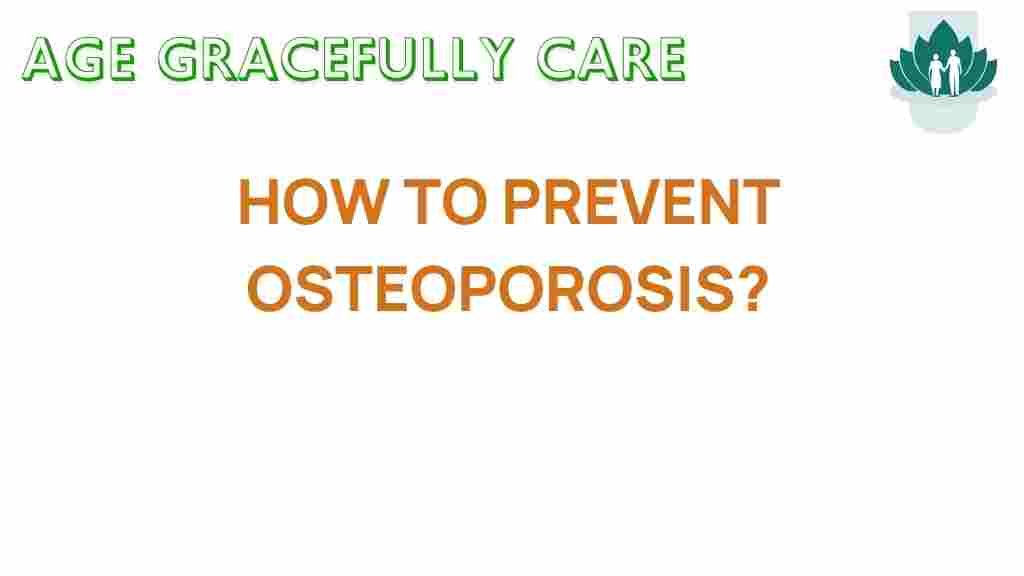Unlocking the Secrets to Preventing Osteoporosis: What You Need to Know
Osteoporosis is a silent disease that weakens bones, making them fragile and more likely to break. As we age, the risk of developing osteoporosis increases, making it crucial to understand the prevention strategies available. In this comprehensive guide, we will explore the importance of bone health, the role of nutrition, exercise, and lifestyle choices in preventing osteoporosis, and how factors such as calcium, vitamin D, and aging affect our bones.
Understanding Osteoporosis
Osteoporosis is often referred to as a “silent disease” because bone loss occurs without any symptoms. It is characterized by low bone mass and deterioration of bone tissue, leading to an increased risk of fractures. Understanding the risk factors for osteoporosis is the first step in prevention:
- Aging: Bone density naturally decreases as we age, particularly after the age of 50.
- Gender: Women are at a higher risk, especially post-menopausal women.
- Family history: A family history of osteoporosis can increase your risk.
- Body frame size: Smaller body frames tend to have a higher risk.
- Diet: Low calcium and vitamin D intake can contribute to weaker bones.
- Lifestyle choices: Sedentary lifestyle, smoking, and excessive alcohol consumption can negatively impact bone health.
Nutrition: The Foundation of Bone Health
Nutrition plays a vital role in maintaining and improving bone health. Here are key nutrients essential for preventing osteoporosis:
1. Calcium
Calcium is crucial for bone formation and maintenance. Adults need about 1,000 mg of calcium daily, which increases to 1,200 mg for women over 50 and men over 70. Excellent sources of calcium include:
- Dairy products (milk, yogurt, cheese)
- Leafy green vegetables (kale, broccoli)
- Fish (sardines, salmon with bones)
- Nuts and seeds (almonds, chia seeds)
- Fortified foods (cereals, plant-based milk)
2. Vitamin D
Vitamin D is essential for calcium absorption. Adults should aim for 600-800 IU of vitamin D daily. The body produces vitamin D through sunlight exposure, but dietary sources include:
- Fatty fish (salmon, mackerel)
- Fortified foods (milk, orange juice)
- Egg yolks
Consider taking a vitamin D supplement if you have limited sun exposure, especially during winter months.
3. Other Nutrients
In addition to calcium and vitamin D, other nutrients also support bone health:
- Magnesium: Found in nuts, whole grains, and green leafy vegetables.
- Vitamin K: Important for bone metabolism, found in leafy greens and fermented foods.
- Protein: Essential for bone structure, found in meat, dairy, and legumes.
Exercise: Building Strong Bones
Regular physical activity is one of the most effective ways to strengthen bones and prevent osteoporosis. Incorporating both weight-bearing and muscle-strengthening exercises into your routine can significantly improve your bone health:
1. Weight-Bearing Exercises
These exercises force you to work against gravity. Examples include:
- Walking
- Jogging or running
- Stair climbing
- Dancing
2. Muscle-Strengthening Exercises
These exercises involve lifting weights or using resistance bands. Examples include:
- Weight lifting
- Resistance exercises
- Bodyweight exercises (push-ups, squats)
3. Balance and Flexibility Exercises
Improving balance can help prevent falls, which are a common cause of fractures in those with osteoporosis. Consider:
- Yoga
- Tai Chi
- Balance training exercises
Lifestyle Changes for Bone Health
In addition to nutrition and exercise, certain lifestyle changes can significantly decrease your risk of osteoporosis:
- Quit Smoking: Smoking has been linked to lower bone density.
- Limit Alcohol Consumption: Excessive alcohol can interfere with calcium balance and hormone levels.
- Maintain a Healthy Weight: Being underweight increases the risk of bone loss, while obesity may lead to inflammation that can harm bones.
Step-by-Step Process to Prevent Osteoporosis
Now that you understand the key elements involved in preventing osteoporosis, here is a step-by-step guide:
Step 1: Assess Your Risk Factors
Identify your risk factors by consulting with your healthcare provider. This includes family history, lifestyle habits, and dietary intake.
Step 2: Optimize Your Nutrition
Ensure you are meeting your daily requirements for calcium, vitamin D, and other essential nutrients. Consider keeping a food diary to track your intake.
Step 3: Create an Exercise Routine
Develop a balanced exercise program that includes weight-bearing, muscle-strengthening, and balance exercises. Aim for at least 30 minutes of physical activity most days of the week.
Step 4: Make Positive Lifestyle Changes
Commit to quitting smoking, reducing alcohol intake, and maintaining a healthy weight. These changes can have a profound impact on your overall health.
Step 5: Regular Check-Ups
Schedule regular check-ups with your healthcare provider to monitor your bone health and adjust your prevention strategies as necessary.
Troubleshooting Tips
If you find it challenging to adopt these changes, consider the following tips:
- Start Small: Make gradual changes to your diet and exercise routine to avoid feeling overwhelmed.
- Seek Support: Join a support group or find a workout buddy for motivation.
- Consult a Nutritionist: A professional can help you create a personalized nutrition plan that meets your needs.
- Use Technology: Fitness apps and online resources can help you track your progress and stay motivated.
Conclusion
Osteoporosis is a serious condition that can lead to debilitating fractures and a reduced quality of life. However, by understanding the importance of nutrition, exercise, and lifestyle changes, you can take proactive steps to prevent this condition. Remember, prevention starts early, so whether you’re in your 30s or approaching 60, it’s never too late to prioritize your bone health. For more information on osteoporosis prevention, check out resources from the National Osteoporosis Foundation.
By making informed choices regarding your diet, physical activity, and lifestyle, you can significantly reduce your risk of osteoporosis and maintain strong, healthy bones for life.
This article is in the category Health and created by AgeGracefullyCare Team

5 thoughts on “Unlocking the Secrets to Preventing Osteoporosis: What You Need to Know”